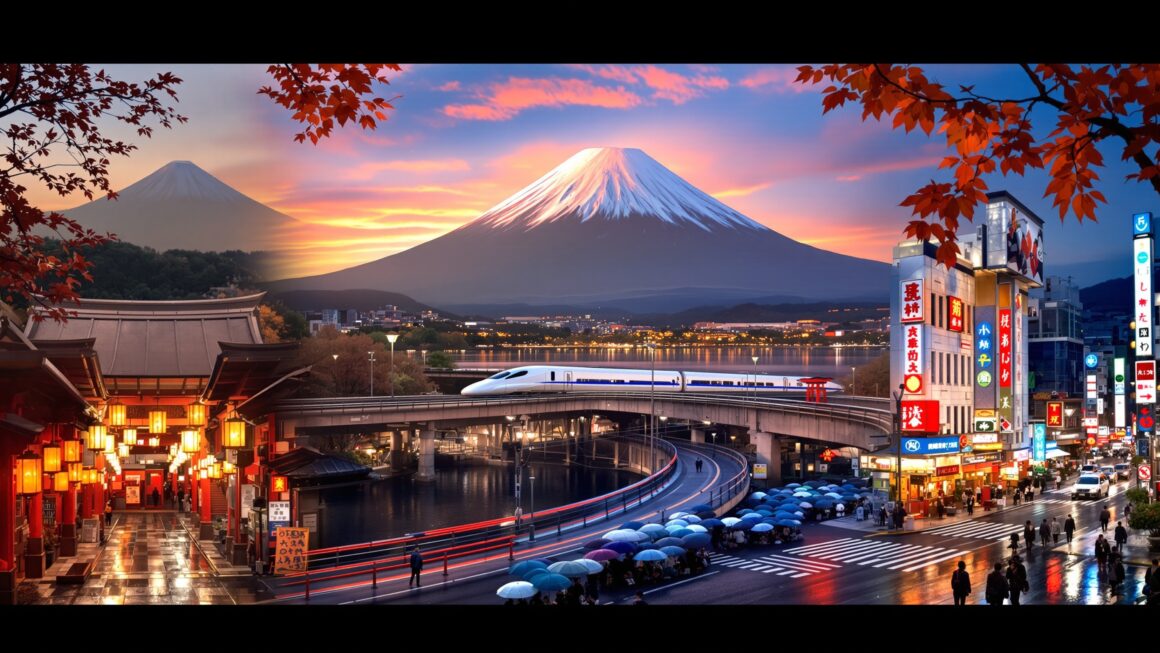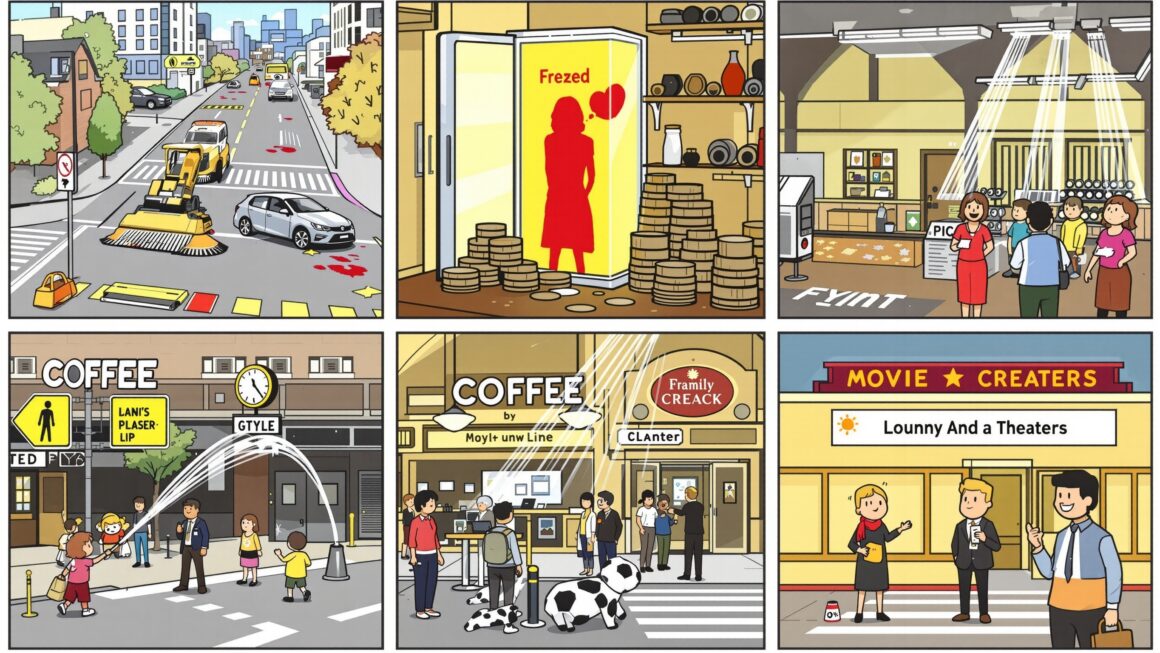Step onto a platform where a bullet train whispers in on time, to the minute, and bows; turn a corner and you’ll find a shrine knotting cedar and silence around a trickle of water. Japan is a country that moves fast without feeling hurried, and that paradox is the key to understanding its spell.
The Paradox in Motion
Japan pairs world-leading tech with centuries-old rituals. A tea master measures breath and temperature like a scientist. A robot greeter bends at the waist as if coached by a Noh actor. Precision, whether in code or in ceremony, is the cultural bridge.
An Archipelago of Many Japans
From the snowscapes of Hokkaidō to the coral blues of Okinawa, each region is a distinct micro-culture.
– Tōhoku: Onsen towns and quiet mountain shrines.
– Kantō: Tokyo’s electric hive, plus surf towns and temple cities.
– Kansai: Kyoto’s lantern-lit lanes, Osaka’s food swagger, Nara’s deer.
– Chūgoku & Shikoku: Inland Sea islands dotted with art sites and citrus groves.
– Kyūshū: Volcanoes, ramen capitals, and seaside hot springs.
Etiquette That Makes a City of Millions Feel Gentle
Politeness isn’t superficial—it’s social engineering.
– Lines form naturally; trains are quiet zones.
– Cashiers hand you change as if returning a gift.
– Shoes off at thresholds; slippers for bathrooms; towels stay out of onsen water.
– Silence can signal respect. A pause is not a void; it’s room for you.
The Taste of Precision (Beyond Sushi)
Japanese cuisine is a map of seasons and micro-technique.
– Washoku: A UNESCO-recognized approach balancing color, texture, and seasonality.
– Ramen: Regional dialects in a bowl—Hakata’s silky tonkotsu, Sapporo’s miso, Kitakata’s curly classics.
– Everyday poetry: Onigiri triangles, tamago sandwiches, convenience-store puddings that punch above their weight.
– Kaiseki: A chef’s calendar served course by course, often arranged to mimic a landscape.
Craft as a Quiet Superpower
Monozukuri (the spirit of making) drives both artisans and engineers.
– From blades in Seki to indigo in Tokushima, craft houses iterate for decades, not quarters.
– In factories, kaizen (continuous improvement) means small, relentless tweaks. It’s why a train door aligns with a painted stripe—and why that matters.
Seasons as a National Pulse
Time is tasted and seen.
– Spring: Hanami under clouds of sakura, where the fleeting is the point.
– Summer: Matsuri drums, fireworks flaring over rivers, cold somen sliding on bamboo.
– Autumn: Crimson momiji and mushroom-rich menus.
– Winter: Snow festivals, hot pot, and steamy rotenburo with frosted views.
Innovation You Can Feel
- Trains: The Shinkansen is engineered for safety and punctuality; its reliability is a civic promise.
- Cities: Earthquake-resistant high-rises sway with intent; vending machines light sleepy alleys; convenience stores function as mini-infrastructure.
- Homes: Toilets with a user manual—and a sense of humor.
Pop Culture With Deep Roots
Anime, manga, and games are global languages, but their grammar borrows from older arts—kabuki’s bold archetypes, haiku’s economy, ukiyo-e’s framing. Modern idols, retro arcades, and vinyl bars coexist with tea rooms and inkstone calligraphy.
Realities Behind the Grace
Japan isn’t an Instagram filter; its strengths grew from solving hard problems.
– Demographics: An aging population spurs robots in care homes and villages that reinvent themselves with creative migration and art projects.
– Work culture: From marathon hours to measured reforms—more flex, more remote, more conversation about balance.
– Resilience: Earthquake drills, sea walls, and neighborhood volunteer networks turn preparedness into muscle memory.
A Mini Field Guide
Useful words:
– Sumimasen: Excuse me/thank you/I’m sorry (polite Swiss army knife).
– Onegai shimasu: Please (when requesting service or help).
– Arigatō gozaimasu: Thank you (polite).
– Daijōbu: It’s okay/No thanks/I’m fine.
Do/Don’t:
– Do queue, speak softly on trains, and tap IC cards (Suica/Pasmo) like locals.
– Don’t eat while walking in crowded streets; don’t tip—gratitude is the tip.
Seven Moments That Feel Like Japan
1) Dawn at a neighborhood shrine, the smell of cedar and incense.
2) A konbini run at midnight that solves dinner and tomorrow’s breakfast.
3) A local sentō, steam curling over tiled murals.
4) The whoosh of a Shinkansen, felt in your chest.
5) A Kyoto alley where a single lantern flickers like a heartbeat.
6) A baseball game where coordinated cheers feel like choreography.
7) Autumn light on a moss garden, time slowed to a drip.
Where to Begin
- Tokyo: Neighborhoods are the point—Shibuya’s energy, Yanaka’s old-town stillness, Kiyosumi’s gardens, Kōenji’s thrift-and-vinyl maze.
- Kyoto & Nara: Temples at sunrise, tea by rivers, deer that bow for biscuits.
- Kanazawa: Gold leaf, samurai lanes, and one of Japan’s finest gardens.
- Naoshima/Setouchi: Ferries to art islands where museums blend into sea and stone.
- Fukuoka: Ramen yatai stalls and breezy bayside walks.
- Sapporo & Niseko: Snow, beer, and mountain air.
Why Japan Stays With You
It’s not just that things work; it’s that they work with care. The country’s quiet power is the attention it gives to the ordinary: a train door, a rice ball, a bow, a pause. In an age that rewards noise, Japan’s most radical act might be its calm.
If you come with patience and curiosity, you’ll find a country that invites you to look closer—and rewards you every time you do.



